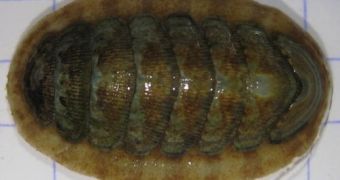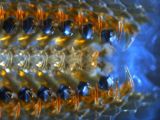A Northwestern University researcher is studying a small marine creature called a chiton, to find out how to make better artificial teeth and bones.
Derk Joester was very intrigued by the way that tiny creatures like oysters and clams, with squishy insides, can make rock hard shells and creatures with squishy insides like humans can make bones and teeth, so he decided to study how the chiton makes its teeth.
Chitons are small, rather flat and oval mollusks, and the one that Joester studies is called Chaetopleura apiculata, and it has a quite strange way of feeding itself.
“This particular organism literally chews rock in order to feed,” Joester explains.
It grinds down rock to get at algae and other food particles that could be trapped inside, “and for that, it needs incredibly tough and hard teeth.”
In fact it seems that chiton teeth are one of the hardest and toughest materials known in nature, and that’s not all – “they also have a very particular structure that allows them to self-sharpen to a certain degree.
“Imagine a knife that keeps its edge forever.”
This is what Joester wants to create in his lab, and it might be possible too, thanks to a relatively new branch of science, called biomaterials.
Biomaterials are inspired by the materials made by plants and animals, and adjusted to make new products that people can use.
Normally, when scientists try to make things in the lab, they usually need very high temperatures and extreme pressures to give materials a certain shape.
And since the chiton only uses seawater and no other special gear to make its remarkable teeth, Joester decided it is a creature worth studying.
Lara Estroff, a professor of materials science and engineering at Cornell University, said that by studying chitons, “we can start to understand what the important design features are, and then start to develop techniques in the lab that might be able to take some of those features out and replicate them.”
But before developing these technique, the researchers need to know how does the chiton makes its teeth, and to do so, they used “one of the most powerful microscopes, the so-called atom probe.”
“The microscope really works by plucking the sample apart, one ion [a charged version of an atom] at a time,” said Joester.
The scientist says that thanks to this equipment they're now getting much more information about the organic proteins that are directing how chiton teeth grow.
“This is an unprecedented level of detail,” says Estroff, adding that the interface between organic and inorganic molecules is the key.
“Anywhere from mollusk shells to teeth to bone, there's always an organic scaffold upon which the inorganic crystals get grown,” she adds.
Joester says that “Nature has had 500-odd million years of a head start in product development.
“[Chitons] have been able to find some really creative and efficient solutions to engineering problems.”
Human engineering problems that the researcher hopes to solve include making a better artificial hip joint or a better dental implant.
This research is presented in the journal Nature, NPR reports.

 14 DAY TRIAL //
14 DAY TRIAL // 
